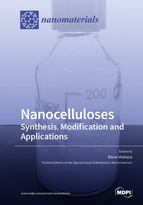Nanocelluloses: Synthesis, Modification and Applications
A special issue of Nanomaterials (ISSN 2079-4991).
Deadline for manuscript submissions: closed (31 August 2019) | Viewed by 52518
Special Issue Editor
Interests: nanocellulose and its application; preparation of hybrid organic–inorganic nanoparticles for biomedical applications; synthesis of carbohydrate derivatives with antimetastatic properties; polymeric materials from natural and synthetic fibers for sanitary and environmental applications; recovery of cellulose from natural and industrial waste for the synthesis of artificial fibers
Special Issues, Collections and Topics in MDPI journals
Special Issue Information
Dear Colleagues,
Nanocelluloses (NCs), namely cellulose-based materials with peculiar physicochemical properties, appear as a new research, offering a wide range of specific applications, quite different from those of cellulose. NC structure, properties, and nanocomposites and NCs have been defined as a new family of nature-based materials. The approach to provide NCs is intimately correlated to the NC source. NC recovery from waste materials is a concrete opportunity to take advantage of cellulose-containing wastes and to enhance them.
Another nanocellulose that has been studied in recent years, and that is prepared by biotechnology, is bacterial nanocellulose (BNC), a nanofibrilar polymer produced by strains such as Gluconacetobacter xylinus. BNC cannot be ignored by researchers interested in nanocellulose due to its unique properties, such as chemical purity, biocompatibility, inertness and non-toxicity, biofunctionality and hypoalergenicity, good mechanical strength, high absorbency, and the possibility of forming any shape and size.
We look forward to receiving your valuable contributions in the forms of reviews, communications, and academic articles.
Prof. Dr. Elena Vismara
Guest Editor
Manuscript Submission Information
Manuscripts should be submitted online at www.mdpi.com by registering and logging in to this website. Once you are registered, click here to go to the submission form. Manuscripts can be submitted until the deadline. All submissions that pass pre-check are peer-reviewed. Accepted papers will be published continuously in the journal (as soon as accepted) and will be listed together on the special issue website. Research articles, review articles as well as short communications are invited. For planned papers, a title and short abstract (about 100 words) can be sent to the Editorial Office for announcement on this website.
Submitted manuscripts should not have been published previously, nor be under consideration for publication elsewhere (except conference proceedings papers). All manuscripts are thoroughly refereed through a single-blind peer-review process. A guide for authors and other relevant information for submission of manuscripts is available on the Instructions for Authors page. Nanomaterials is an international peer-reviewed open access semimonthly journal published by MDPI.
Please visit the Instructions for Authors page before submitting a manuscript. The Article Processing Charge (APC) for publication in this open access journal is 2900 CHF (Swiss Francs). Submitted papers should be well formatted and use good English. Authors may use MDPI's English editing service prior to publication or during author revisions.
Keywords
- nanocellulose
- waste recovery
- nanocellulose composites
- bacterial nanocellulose
- industrial applications of nanocellulose
- biomedical applications of bacterial nanocellulose







